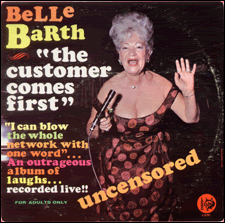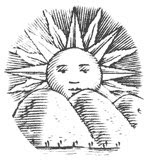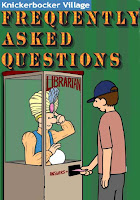 I was waiting till I passed a 1000 posts to post this one. Somehow it led me to a story about Belle Barth. Randi Rhodes has actually brought back the humor of the old Jewish bawdy women comics of the 50's and 60's with her RUSTY WARREN CLIP. I think every one of my friends' parents had a Belle Barth record. Certainly Sam Hanana and Jerry Cohen did. Sam Hanana had to be (for my money) the funniest, raunchiest guy in Knickerbocker Village. Here's a story from the Boston Phoenix about these comics (and mit in drinen there's the Junk in the Box photo)
I was waiting till I passed a 1000 posts to post this one. Somehow it led me to a story about Belle Barth. Randi Rhodes has actually brought back the humor of the old Jewish bawdy women comics of the 50's and 60's with her RUSTY WARREN CLIP. I think every one of my friends' parents had a Belle Barth record. Certainly Sam Hanana and Jerry Cohen did. Sam Hanana had to be (for my money) the funniest, raunchiest guy in Knickerbocker Village. Here's a story from the Boston Phoenix about these comics (and mit in drinen there's the Junk in the Box photo)Funny girls talk dirty ‘Shut your hole, honey. Mine’s making money.’
BY MICHAEL BRONSKI
UNABASHEDLY SEXUAL: in an era remembered for The Donna Reed Show, female Jewish comics played to an audience of conventional bourgeois adults.WHEN WOMEN talk openly about sex, it’s always big news. It was, indeed, the man-bites-dog story of the past half-decade, when Sex and the City was critically praised for breaking taboos about women and sex talk: not only do Carrie and her friends like having sex, they like talking about everything from erogenous zones to how their boyfriends’ semen tastes. Then there’s stand-up comic and actress Margaret Cho, whose one-woman shows and films such as Notorious C.H.O. entertain audiences with talk about such matters as how much she (and her mother) enjoy looking at Ass Master, a gay-male-porn magazine.
But is this new? In the 1950s and early ’60s, a group of working-class New York Jewish women — Belle Barth, Pearl Williams, and Patsy Abbott — were famous (well, infamous) for talking about sex. In fact, they said things in their nightclub acts and on their comedy LPs that Sex and the City wouldn’t dream of including. They rivaled Margaret Cho’s edgy comedy with the sheer, massive bulk of their vulgarity and indelicacy. But they have been, almost entirely, lost to history.
When I first saw ads for Gerald Nachman’s recently published Seriously Funny: The Rebel Comedians of the 1950s and 1960s (Pantheon), I hoped he would explore the lives and work of these women. But while he gives Barth a few begrudging paragraphs and mentions Williams a meager three times, he essentially dismisses them as "burlesque refugees" whose "material had no redeeming anything except guffaws." It’s a shame, because in their own ways, Barth, Williams, and Abbott were as radical — and political — as Lenny Bruce and Mort Sahl, who rose to prominence in the years of these women’s decline. Often, they were also a lot funnier. Here’s Pearl Williams: This broad goes to an eye doctor. He holds up a chart with letters and says, "Can you read this?" She says, "No." He holds up another chart with bigger letters. "Can you see this?" "No," she says. He holds up another chart with huge letters. "Can you see this?" "No," she says. He takes out his schlong and says, "Can you see this?" "That I can see," she says. "Oh, that’s your problem," he says. "You’re cockeyed."
Okay, it’s hardly a great joke (although it isn’t bad), but for the time it was shocking, not just for its language, but for its intimation that women’s sexual desire was equal to men’s.
WHO WERE THESE women? Where did they come from, and where did they go? As I began doing research I found that there just wasn’t much information about them out there. I discovered that Belle Barth’s birth name was Annabelle Salzman. Novelist and historian Lisa Davis told me she had heard that Pearl Williams was a lesbian, but her informants were long dead and I couldn’t confirm the claim. A close friend told me that in the ’50s, her parents would go to business conventions in Manhattan and loved to see Patsy Abbott’s nightclub act, and that her unofficial theme song was "They Don’t Make Jews Like Jesus Anymore."
Most of that, of course, is anecdotal hearsay. What we do know is that these women did not play the so-called borscht-belt clubs because women comics were, with very few exceptions, not booked in the more fashionable Catskill resorts popular among upwardly mobile East Coast Jews in the postwar years. The men who worked these resorts — Buddy Hackett, say, or the truly vulgar "Tubby" Boots — were every bit as filthy-minded and ribald as Barth, Williams, and Abbott, but the women were not welcome. Instead, they played Miami Beach, New York, and Toronto night clubs — usually the "late night" slot, when the crowds were drunker, rowdier, and more open to having a good time. Patsy Abbott (born Goldie Schwartz) had her own club called Patsy’s Place. Barth and Williams played the smaller rooms at noted hotels like the Fontainebleau or New York night clubs that were a string below the Latin Quarter or El Morocco. Barth was famous enough to land a Carnegie Hall gig, but had to censor her material. Beyond this general picture, it’s nearly impossible to track down specific information about these performers.
What we do have, however, are their LPs. Barth released 11 records on various labels, including the terrific If I Embarrass You, Tell Your Friends. Williams released at least nine, and Abbott, the least well-known of the three, released only two, though she may have come up with the best dirty title: Drink Up, Your Behind. These records, recorded live at the nightclubs where the women performed, were promoted as "adult party records" — often sold under the counter at record stores, and, once home, usually sequestered from the "family" LPs. They were, in many ways, part of an underground culture that offered fare not unlike the more sexually explicit comics and books of the more liberated late ’60s. But it was an underground culture intended for, and consumed by, conventional bourgeois adults, not rebellious young people. As such, these LPs not only give us surprising insights into women in the ’50s, but also expose that decade’s rarely acknowledged, explicitly woman-centered sexual underside. Everyone knows that in the 1950s, mass-circulation "men’s" magazines like Playboy emerged alongside the wholesome imagery of Father Knows Best. But in those publications, women were passive objects; these comics were anything but passive.
The rest of the article can be viewed here























No comments:
Post a Comment